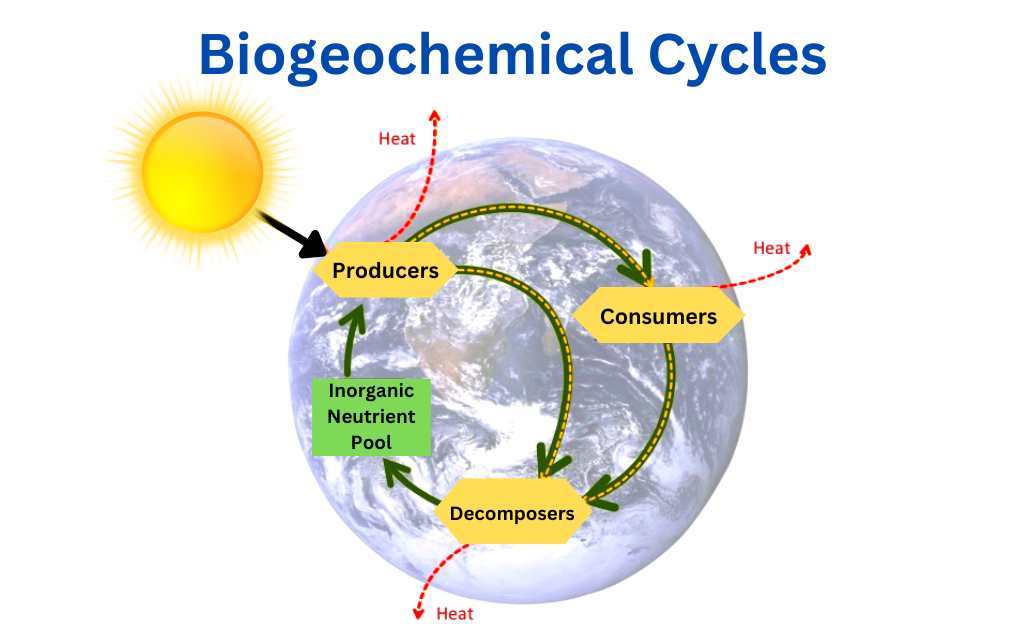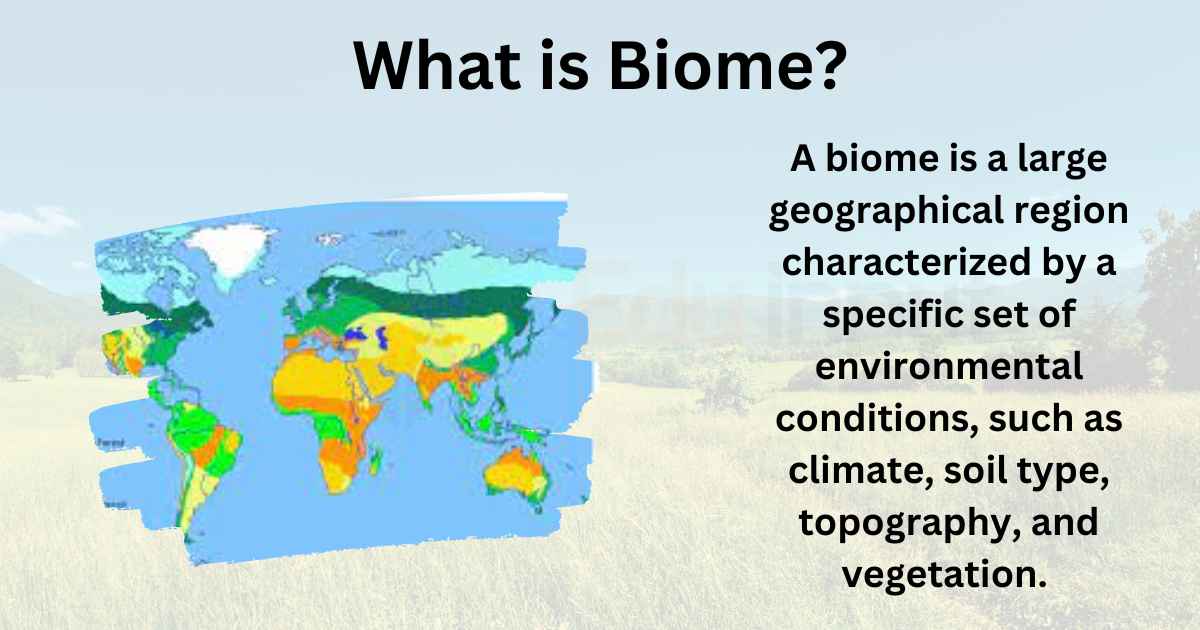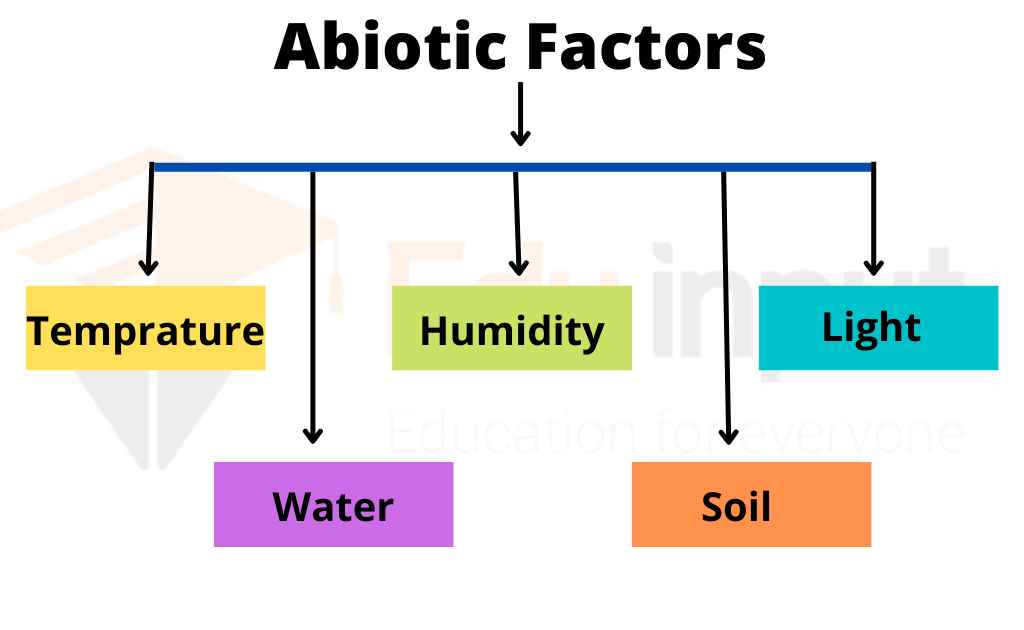Introduction to Biogeochemical Cycles
The movement of some elements between biotic and abiotic factors is referred to as biogeochemical cycles. It is derived from the word bio, meaning the biosphere, geo, geological components, and chemical, and elements that move through a cycle.

Water Cycle
The water from the different water bodies falls to the ground as rain. The water cycle is in charge of weather conditions. The temperature and pressure of the atmosphere can be influenced by water in its various forms.
The water cycle is a continuous, self-regulating mechanism of the Earth and atmosphere. It shows the continuous flow of water in a cycle. It is a complicated system that includes many different processes.
Water changes into water vapor and then becomes part of the air, which condenses to form clouds. Rain or snow falls to the ground.
Carbon Cycle
Plants use CO2 and light to make Glucose. That means, plants take carbon dioxide from the atmosphere and store it as fossil fuels in their tissues. In this process, plants die and their bodies are then buried in the soil.
Fossil fuels, when burned, release carbon dioxide into the atmosphere. Animals eat plants, and this way carbon is transferred to them.
The carbon cycle manages how many times those same carbon atoms move around. They move from the atmosphere into plants and animals, then back into the atmosphere, and then back into the ground. That’s the carbon cycle.
Most carbon is stored in rocks and sediments, but some are also stored in living organisms and the atmosphere.
Nitrogen Cycle
The process of converting nitrogen into several different forms is called the nitrogen cycle. Nitrogen passes from the atmosphere into the soil and then to different organisms. The nitrogen cycle is also involved in the matter-decaying processes.
Prokaryotes play an important role in the nitrogen cycle. Inorganic nitrogen is fixed by the soil bacteria, which makes the nitrogen available to the plant.
The nitrogen gas from the plants is converted into a compound called ammonia by a group of bacteria present in the root nodules of plants. Ammonia is converted into Nitrites and Nitrates. Then Denitrifying bacteria reduce these nitrates and nitrites into nitrogen and return to the atmosphere.
Oxygen Cycle
Oxygen is an abundant element on Earth. An oxygen cycle is the movement of oxygen through the atmosphere, biosphere, and the earth’s crust. The oxygen cycle shows how free oxygen is made available in each of the regions, and how it is used.
The Oxygen Cycle starts when plants are exposed to sunlight and produce oxygen as a waste product. Humans and animals breathe this oxygen in and exhale carbon dioxide. The plants take carbon dioxide and use it for energy, which allows us to breathe in more oxygen.
Phosphorus Cycle
The phosphorus cycle is the process by which phosphorus moves from the lithosphere to the hydrosphere to the biosphere. The main biological role of phosphorus is the formation of nucleotides, which are the building blocks of DNA and RNA. It is also present between the double helix of DNA.
Plants and animals get this phosphorus from the soil and water. Microorganisms decompose the dead bodies of plants and animals and get phosphorus from that organic matter. This phosphorus is then returned to the soil for being consumed by plants and animals.
Without phosphorus, we could not have life. It’s a fundamental building block in the genetic code of life on Earth, the composition of cell membranes, and it supports all other elements of the Earth’s food chain.
Sulfur Cycle
The sulfur cycle is the cycle through which sulfur moves throughout the earth. Sulfur is released through weathering of rocks, and then it is absorbed by plants. This sulfur passes through the food chain. Plants and animals absorb this sulfur and release it into the outer environment after a breakdown.
Microorganisms and plants take up sulfates in raw form and convert them into organic form. These organic compounds are used by animals. Animals decompose the sulfur, and it is again returned to the soil and the cycle continues.
Why Biogeochemical Cycles Are Important?
By knowing biogeochemical cycles, we can see how the energy is utilized. The essential elements are moved through the system. These ecological cycles show the relationship between the living and non-living things in the environment and are important for the survival of the ecosystems.
Understanding these cycles helps you better comprehend their effects on our environment. Some activities of humans disrupt the natural order of life and may affect the environment.
Related FAQs
What is the biogeochemical cycle and its importance?
The movement of some elements between biotic and abiotic factors is referred to as biogeochemical cycles.
By knowing biogeochemical cycles, we can see how the energy is utilized. The essential elements are moved through the system.
Which biogeochemical cycle is most important?
The oxygen cycle is the most important. The oxygen cycle shows how free oxygen is made available in each of the regions, and how it is used.
What are the major biogeochemical cycles?
Here are the major biogeochemical cycles.
Water Cycle
Carbon Cycle
Sulphur Cycle
Nitrogen Cycle
Phosphorus Cycle
What happens to nutrients in a biogeochemical cycle?
Many nutrients move around the ecosystem through biological processes, such as photosynthesis, decomposition, and nutrient cycling, as well as through physical mediums, such as water and wind.

 written by
written by 




Leave a Reply